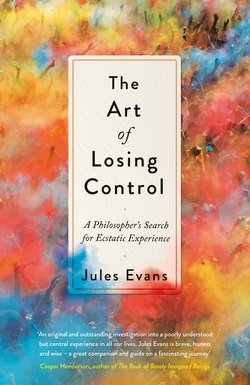Читать книгу The Art of Losing Control - Jules Evans - Страница 7
На сайте Литреса книга снята с продажи.
ОглавлениеList of Illustrations
Paleo-anthropologists think cave paintings like these at Lascaux (from around 20,000 BC) were an early route for homo sapiens to reach altered states of consciousness. © Sisse Brimberg/National Geographic
Ecstasy also had a central role in classical culture – this vase painting (right) shows a maenad filled with the god Dionysus. © The Trustees of the British Museum
In Christian culture, ecstasy is interpreted as an invasion by God, though it could also be demonic possession or human imagination.
Two examples from Caravaggio – above, Saint Matthew and the ecstasy of creative inspiration. Below, Saint Paul and the ecstasy of sudden conversion.
Hogarth’s ‘Enthusiasm Delineated’ (c.1760) mocked the unbridled emotionalism of Methodist services. © The Trustees of the British Museum
A late-19th-century photo from the Salpêtriére clinic in Paris showing a hysteric patient in ecstatic attitude. Western psychiatrists often interpreted spiritual experiences as symptoms of mental pathology. © Yale University, Harvey Cushing/John Hay Whitney Medical Library
A 19th-century Methodist camp meeting in the US. © Courtesy of the New Bedford Whaling Museum
Rock and roll secularized the ecstasy of charismatic Christianity and brought it to the masses. This is the audience at a Beatles concert in Plymouth in 1963. © Mirrorpix
Stanley Kubrick’s 2001: A Space Odyssey (1968) imagined ecstatic encounters with extraterrestrial intelligences. Directors including Kubrick have used cinema to explore altered states and provoke them in the audience. © Warner Bros
Shakespeare’s theatre offered a playful, sceptical space for ecstasy (this is Vivien Leigh as Titania in a 1937 production of A Midsummer Night’s Dream). © Photograph by JW Debenham. Courtesy of the Mander and Mitchenson Collection at the University of Bristol
Casper David Friedrich’s ‘Wanderer Above the Sea of Fog’ (c.1818). © bpk | Hamburger Kunsthalle | Elke Walford
Extreme sports have also been embraced as a means to ecstatic experiences in nature – the image below is from Werner Herzog’s 1974 documentary about a ski-jumper, The Great Ecstasy of Woodcarver Steiner. © Deutsche Kinemathek – Werner Herzog Film
The Romantic counter-culture explored ecstatic experiences through poetry, free love and intoxicants. Above is a frontispiece by William Blake, a keen practitioner of sexual spirituality.
A photo from the 1969 Woodstock festival. Such experiments in ecstasy became a mass phenomenon during the 1960s.
Ecstatic nationalist movements like Nazism offer ecstasy through the worship of the state and its Leader, and through a narrative of sacred war against demonised outsiders. © Corbis Historical/Getty Images
An image of the myth of King Pentheus, torn apart by the demented followers of Dionysus. © 2017. Kimbell Art Museum, Fort Worth, Texas/Art Resource, NY/Scala, Florence
